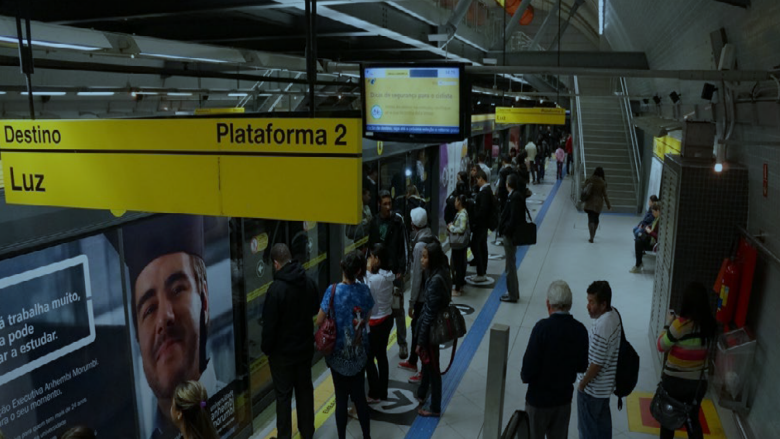Results
Line 4 has substantially improved the quality of service provided to urban transport users in the area of influence served by the project’s Phase 2.
Reduced travel times have contributed to increased demand and level of service. Line 4 transports daily close to 750,000 passengers. It is expected to reach close to 1 million in 2020.
The line offers the latest technology, comfort, and safety. Line 4 is the first driverless heavy-capacity metro in South America. It incorporates the latest train operation technology (Communications-Based Train Control), including platform screen doors that open when the train arrives, improving safety, speed, and regularity in boarding times, and information systems informing passengers about train capacity. The entire line allows cellular reception.
All stations are physically integrated with buses near stations or by direct connection to a bus terminal (Four new bus terminals were built, financed by the project.). According to the latest user satisfaction survey, integration with other metro lines and buses is considered “very good” by 80 percent of users. Tariff integration (Bilhete Unico) was put in place in 2006, during the first phase of the project, and allows free transfers between all rail-based modes and bus systems using contactless fare cards.
Accessibility to jobs and urban amenities has increased, especially for low- and middle-income areas near Vila Sônia. Residents in these areas can now access, within a 60-minute trip, more than twice the number of employment positions than they could before the project.
Bank Group Contribution
The World Bank, through the International Bank for Reconstruction and Development (IBRD), provided $340 million to the São Paulo Metro Line - Phase 2. The Bank’s contribution, split into two loans, constitutes 54 percent of Phase 2 costs. The Bank’s first loan — São Paulo Metro Line 4 (Phase 2) — provided US$130 million, 22 percent of the overall estimated final cost of the project. The remaining US$210 million is financed by the São Paulo Metro Line 5 Project, which had achieved savings and was therefore extended and restructured to include the final civil works of Line 4.
Partners
External financing for the public civil works of the São Paulo Metro Line 4 (Phase 2) was co-financed by the Japan Bank for International Cooperation (JBIC) and the Bank. Each financed close to 22 percent of the initial total costs (US$130 million), while counterpart funding was expected to be 57 percent. The Bank provided implementation support on behalf of JBIC. In December 2015, the borrower requested use of US$210 million in savings obtained under the São Paulo Metro Line 5 Project to address the financing needs of Line 4, thus reducing direct counterpart funding in a tight fiscal situation for the State of São Paulo.
Similar to Phase 1, Phase 2 relied on the private concessionaire ViaQuatro for the acquisition of new trains and the operation and maintenance (O&M) of the newly constructed stations. The 30-year concession contract includes operation of the Metro Line 4 as well as investment and installation of rolling stock, signs, track connections, and data transmission in the train networks. This PPP agreement was signed during Phase 1 (2006) and continued to work successfully during Phase 2, providing a great example of the benefits of using the Maximizing Finance for Development framework in the context of large transport infrastructure investments. ViaQuatro supplied 14 trains in Phase 1 and 15 additional trains during Phase 2. Concessionaire ViaQuatro used an estimated US$450 million of private financing for O&M on Line 4 between 2010 and 2018.
Beneficiaries
Passenger Andressa Gomes Santos lives in Paraisópolis, in São Paulo’s south zone. She commutes using Line 4. “The headway between trains is very short, and I save 60 minutes in my daily commute, besides the $2 dollars a day given that I don’t need to get the bus to reach the Metro.”
Giane Maria Freitas da Silva lives in Cotia, a western area of São Paulo and uses Line 4 both for commuting and over the weekends for leisure traveling, integrating with Line 2. “I am saving between 20 and 30 minutes every day, and I am very pleased with the comfort it provides.”
Wanderson Adelino Dias Fernandes lives in the Paraisópolis, in the south zone of São Paulo, and commutes to work using Line 4. “I am surprised with so much technology like the platform doors to increase safety for the users. The trains are so much faster than the buses, and I save between 40 to 60 minutes in my daily commute.”
Moving Forward
Although significant gains in rider benefits have already been achieved, Line 4 is not yet complete. One station and its access tunnel are still under construction and, with financing under a Bank loan, are due to be completed by 2020. Travel time gains between Vila Sônia and Luz are then expected to be even greater: The two ends of the line will be reachable within 20 minutes. The Bank’s continued support ensures the financial and technical sustainability of the project, as does the commitment of the State of São Paulo to improving the quality of urban mobility for its residents. Promoting urban sustainable mobility has been one of the main pillars of the SPMR’s 16-year Strategic Master Plan, developed in 2014, which included ambitious actions such as the introduction of parking minimums, promotion of a biking culture, and strong investments in mass transit.
